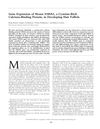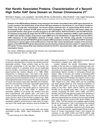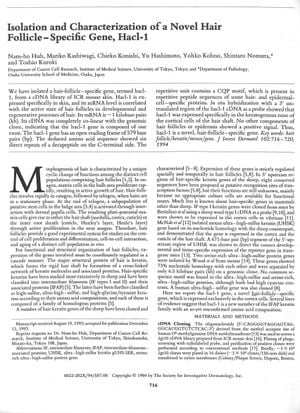TLDR Researchers found a new gene, hacl-1, that is active in mouse hair follicles during hair growth and may be important for hair biology.
In 1994, researchers discovered a new gene, hacl-1, which is specifically expressed in the hair follicles of ICR mice. This gene is unique to the skin and its expression is linked to the active growth phases of hair follicles. The hacl-1 gene is composed of a single exon and encodes a protein with a distinctive structure, featuring six repeats of a decapeptide. It is particularly expressed in the keratogenous zone of the hair shaft's cortical cells, and not in other parts of the hair follicle or the epidermis. The gene's expression pattern suggests it may belong to the intermediate-filaments-associated proteins (IFAP) keratin family, although its amino acid composition was not typical for this family. The specific expression of hacl-1 in hair follicles, especially during periods of active hair growth, indicates its potential importance in hair biology and its possible applications in medical and cosmetic fields for hair growth and regeneration.
745 citations
,
February 1992 in “Trends in genetics” Hair follicles create different cell layers and proteins, controlled by various molecules.
98 citations
,
December 1991 in “Annals of the New York Academy of Sciences” Keratin gene regulation is similar across mammals, affecting hair follicle differentiation.
27 citations
,
November 1991 in “Journal of Investigative Dermatology” 26 citations
,
December 1990 in “Journal of Biological Chemistry” Two specific genes are more active during hair growth in mice.
67 citations
,
December 1990 in “The journal of cell biology/The Journal of cell biology” Researchers found genes for cysteine-rich proteins that form the protective layer of hair in humans and sheep.
33 citations
,
September 1990 in “Proceedings of the National Academy of Sciences” The study showed that a specific DNA sequence can control gene expression in hair growth areas of mice.
51 citations
,
March 1990 in “Journal of Investigative Dermatology” 38 citations
,
February 1989 in “Journal of Investigative Dermatology” 41 citations
,
December 1988 in “Journal of Investigative Dermatology”
47 citations
,
September 2004 in “Journal of Biological Chemistry” Hoxc13 regulates specific hair protein genes on mouse chromosome 16.
 40 citations
,
November 1998 in “The journal of investigative dermatology/Journal of investigative dermatology”
40 citations
,
November 1998 in “The journal of investigative dermatology/Journal of investigative dermatology” S100A3 protein is crucial for hair shaft formation in mice.
 98 citations
,
June 2001 in “Journal of biological chemistry/The Journal of biological chemistry”
98 citations
,
June 2001 in “Journal of biological chemistry/The Journal of biological chemistry” A cluster of sulfur-rich hair protein genes was found on chromosome 17.
 62 citations
,
January 2004 in “The journal of investigative dermatology/Journal of investigative dermatology”
62 citations
,
January 2004 in “The journal of investigative dermatology/Journal of investigative dermatology” A second domain of high sulfur KAP genes on chromosome 21q23 is crucial for hair structure.
 194 citations
,
May 2000 in “Journal of Investigative Dermatology”
194 citations
,
May 2000 in “Journal of Investigative Dermatology” The hedgehog signaling pathway is crucial for hair growth but not for the initial creation of hair follicles.




